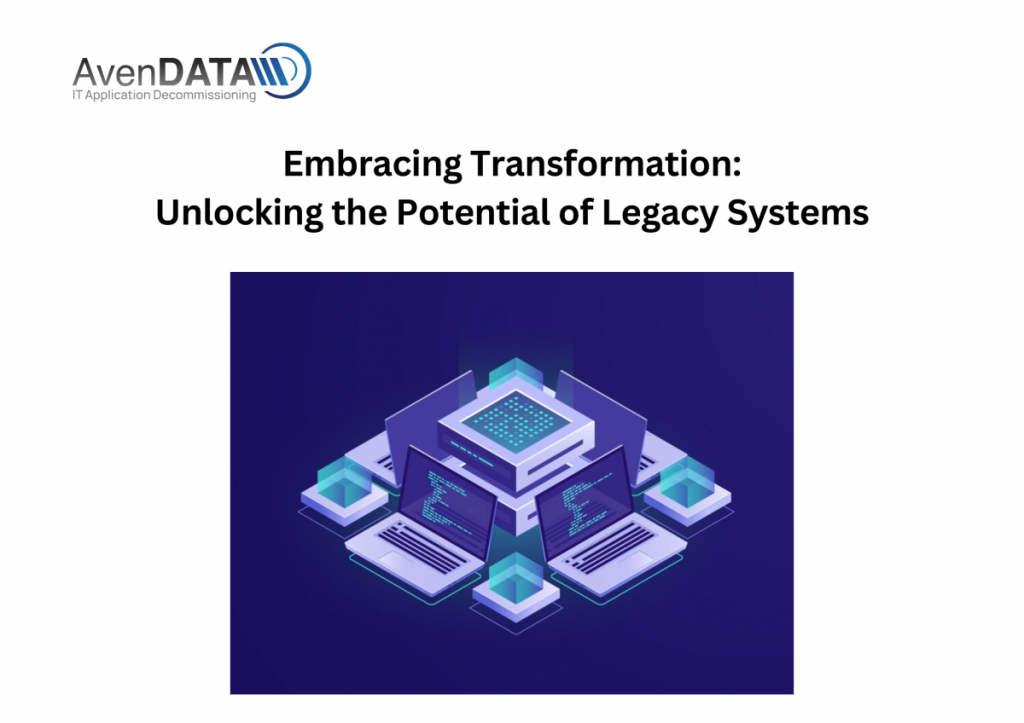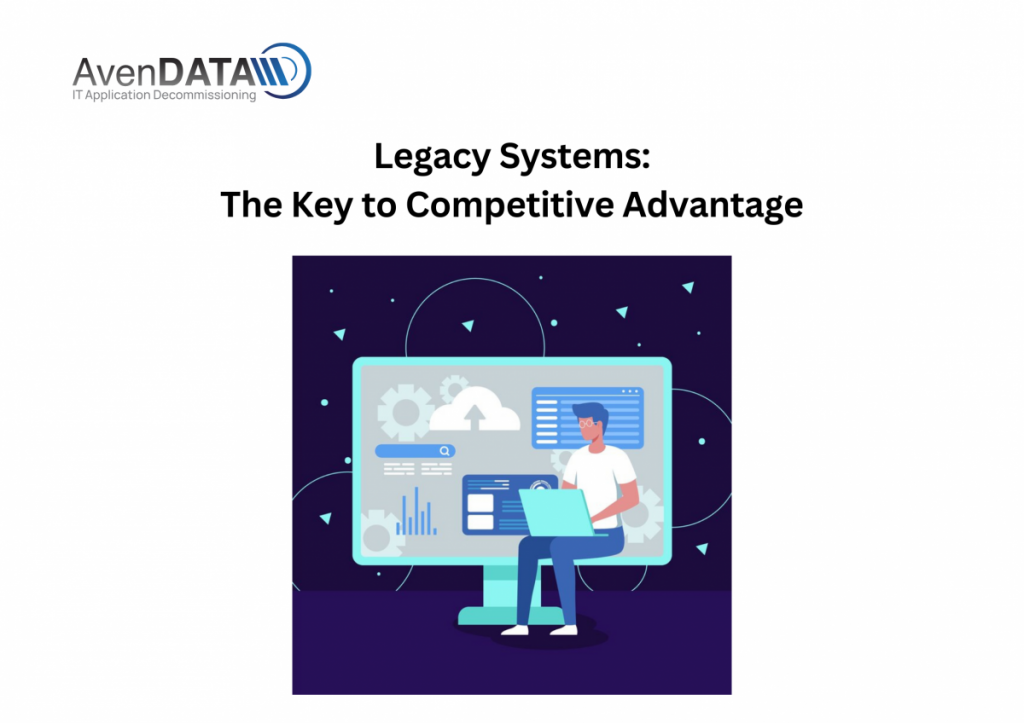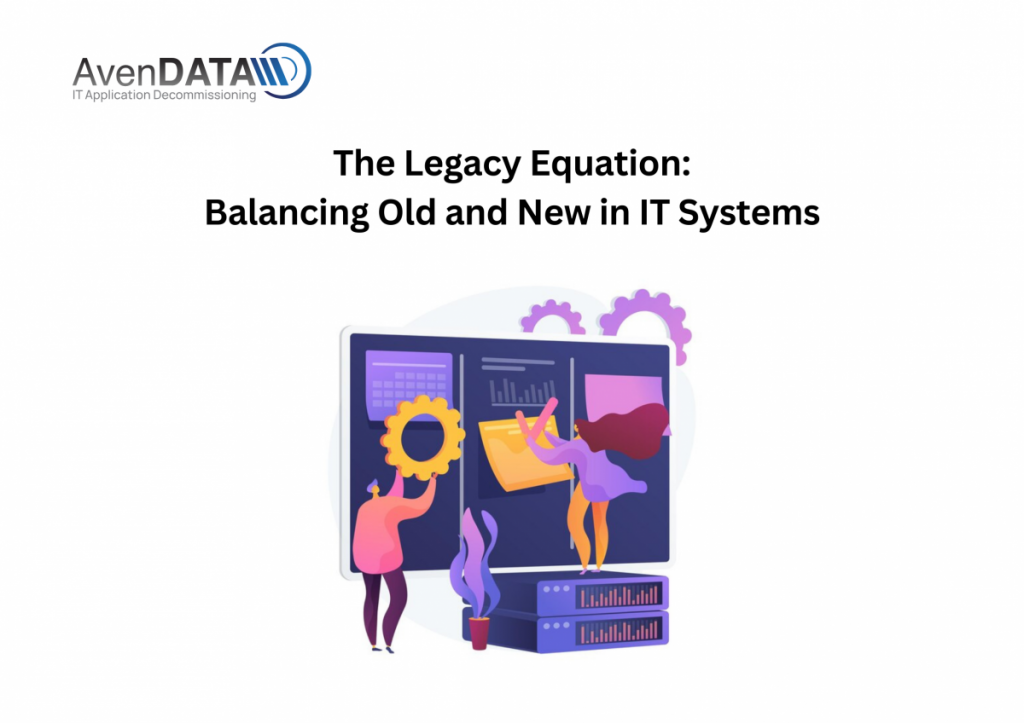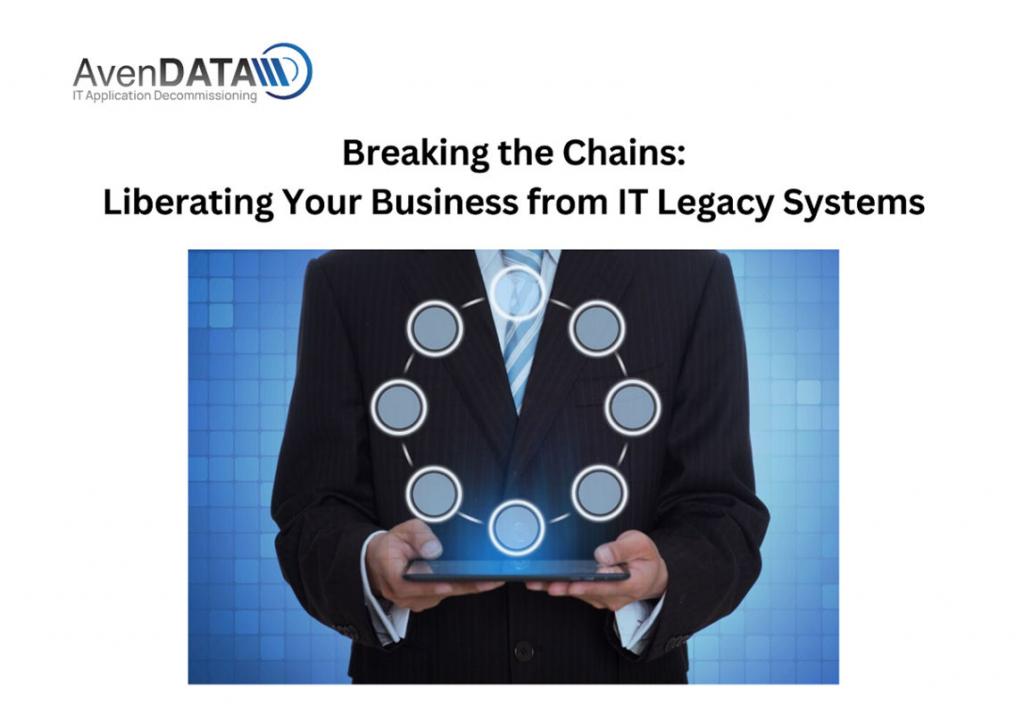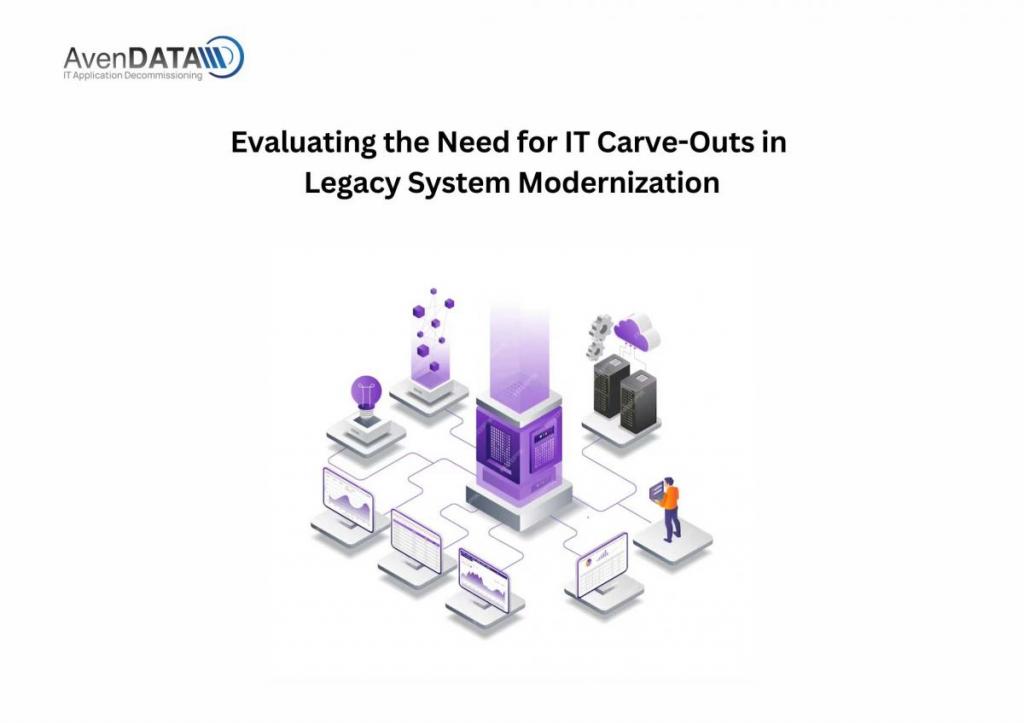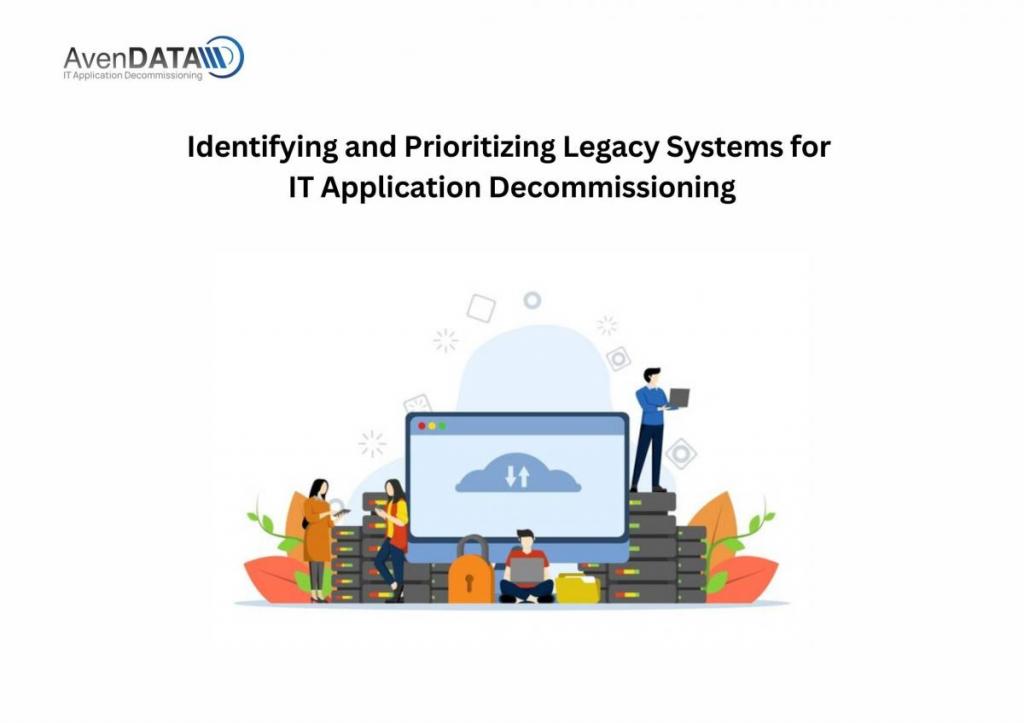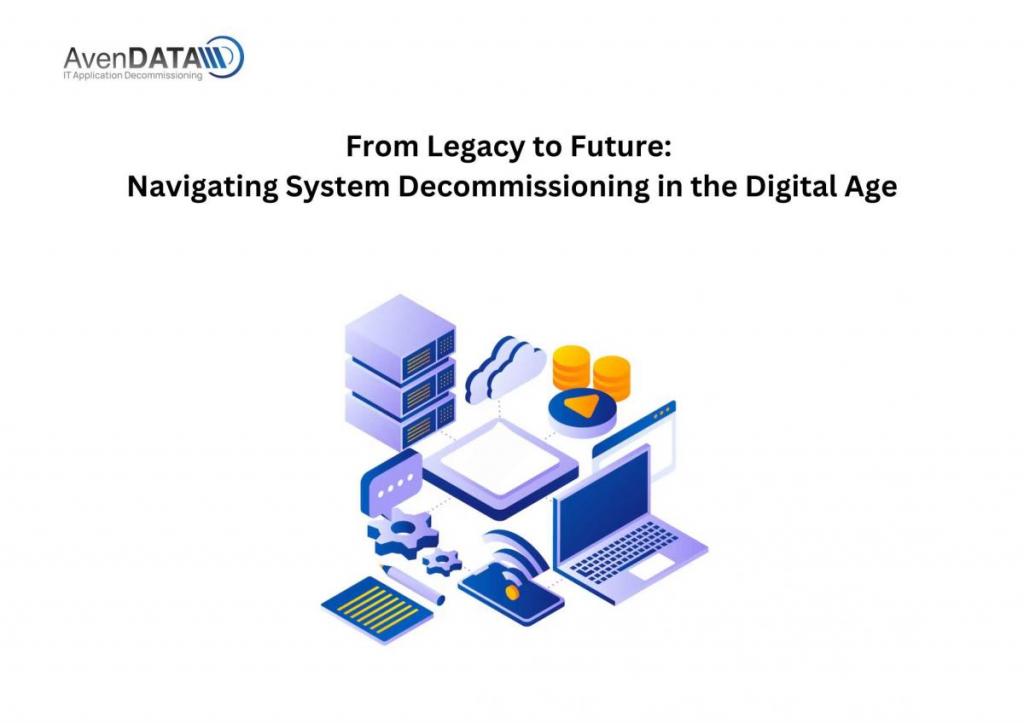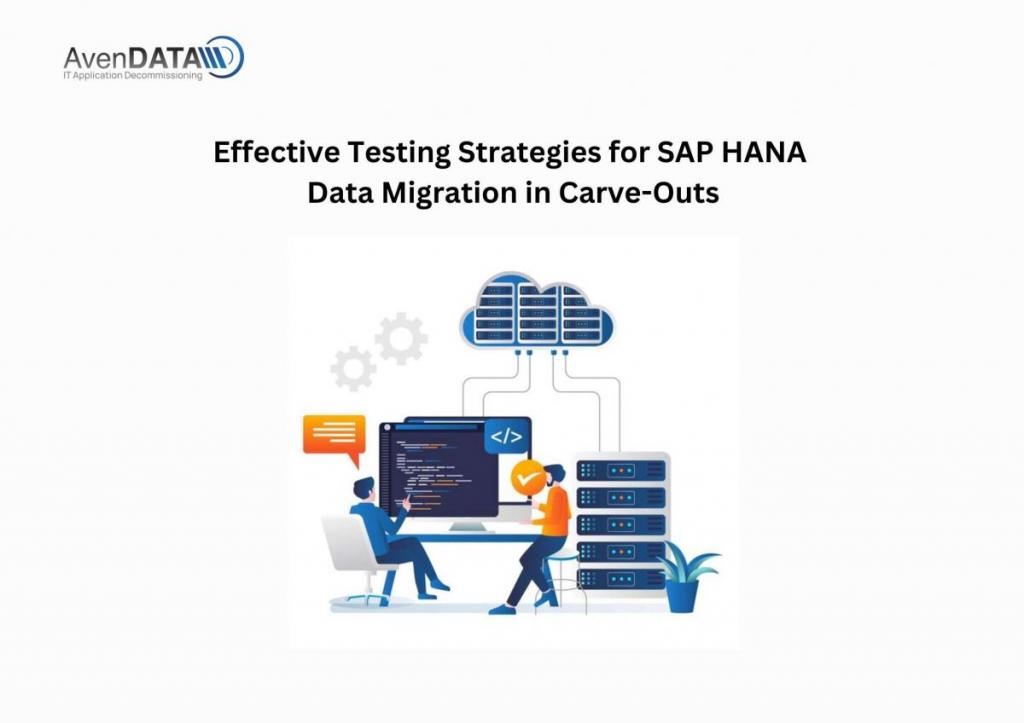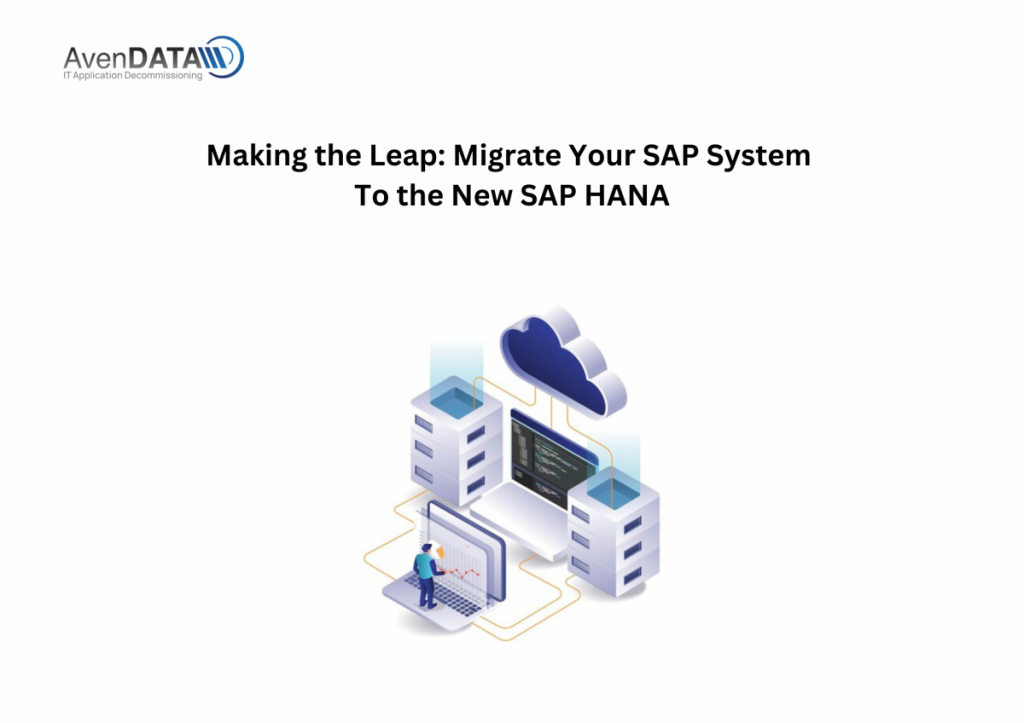Do it like Rosi! Archive your legacy systems with us!
Whether ERP or CRM systems, unstructured data or files you have, we will build an archiving system for you that will free you from your legacy sy... View MoreDo it like Rosi! Archive your legacy systems with us!
Whether ERP or CRM systems, unstructured data or files you have, we will build an archiving system for you that will free you from your legacy systems at the same time fulfilling legal requirements. Benefit from our many years‘ experience in the market, which is reflected in the hundreds of our archiving projects worldwide
Embracing Transformation: Unlocking the Potential of Legacy Systems
Introduction: Legacy systems have long been considered the outdated relics of the past, often perceived as barriers to innovation ... View MoreEmbracing Transformation: Unlocking the Potential of Legacy Systems
Introduction: Legacy systems have long been considered the outdated relics of the past, often perceived as barriers to innovation and progress. However, it’s time to challenge this perception and recognize the untapped potential that lies within these systems. In this blog, we explore how organizations can embrace transformation and unlock the hidden value of their legacy systems, paving the way for innovation, efficiency, and sustained success.
Reassessing Legacy Systems: To unlock the potential of IT legacy systems, organizations must first reassess their value and capabilities. Instead of viewing them as obstacles, consider the following perspectives:
a. Institutional Knowledge: Legacy systems often contain valuable institutional knowledge and insights that have been refined over time. This expertise can provide a competitive advantage by enabling organizations to make informed decisions, anticipate customer needs, and optimize processes.
b. Stability and Reliability: Legacy systems, though built on older technologies, have a proven track record of stability and reliability. By preserving and optimizing these systems, organizations can ensure uninterrupted service delivery, build customer trust, and maintain a competitive edge.
c. Integration Capabilities: Legacy systems are often deeply integrated with other applications and processes within an organization. This integration capability can be leveraged to seamlessly connect with new technologies, enabling a gradual and cost-effective modernization process.
Modernizing in Phases: To embrace transformation, organizations can adopt a phased approach to modernizing their legacy systems. This approach allows for a gradual transition, minimizing disruption and maximizing the value derived from existing investments. Key steps in the modernization process include:
a. Assessing Modernization Needs: Identify areas where legacy systems are hindering business growth or efficiency. Determine the specific functionalities or components that require modernization and align them with strategic objectives.
b. Defining a Modernization Strategy: Develop a comprehensive strategy that outlines the timeline, goals, and resources required for modernization. Consider factors such as budget constraints, risk mitigation, and the impact on existing operations.
c. Prioritizing Modernization Efforts: Prioritize the functionalities or components that will yield the most significant benefits when modernized. This may include customer-facing applications, backend processes, or data management systems that have a direct impact on business outcomes.
d. Leveraging Hybrid Solutions: Rather than discarding legacy systems entirely, embrace hybrid solutions that combine the strengths of both legacy and modern technologies. This approach allows for a seamless integration of new capabilities while preserving the core functionality and institutional knowledge of legacy systems.
Implementing Agile Development: Adopting agile development methodologies can greatly facilitate the modernization process of legacy systems. By breaking down the modernization effort into smaller, manageable tasks, organizations can iterate, test, and deploy updates more efficiently. Agile development enables faster response times, increased collaboration, and a higher level of adaptability to evolving business needs.
Investing in Training and Change Management: Successful transformation requires investing in training and change management initiatives. Empower employees with the necessary skills and knowledge to embrace new technologies and processes. Communicate the benefits of modernization, address concerns, and foster a culture of continuous learning and adaptation.
Ensuring Security and Compliance: As organizations modernize their legacy systems, it is crucial to prioritize security and compliance. Implement robust cybersecurity measures, regularly update software, and conduct thorough vulnerability assessments. Ensure compliance with industry regulations and data protection laws to safeguard sensitive information and maintain trust with customers.
Conclusion: Legacy systems should no longer be viewed as barriers to innovation, but rather as untapped opportunities for organizations to embrace transformation. By reassessing the value of legacy systems, adopting a phased modernization approach, implementing agile development methodologies, investing in training and change management, and prioritizing security and compliance, organizations can unlock the potential of their legacy systems. Through this transformation, organizations can drive innovation, improve efficiency, and position themselves for sustained success in the dynamic and ever-evolving business landscape. Embrace the power of transformation, and unlock the hidden potential within your legacy systems.
Know more : https://avendata.com/archiving-legacy-systems
#avendata #legacysystems #legacysystem #itsystems #itlegacysystems
Legacy Systems: The Key to Competitive Advantage
Introduction: In today’s fast-paced technological landscape, organizations often perceive legacy systems as outdated and inefficient. However, it is... View MoreLegacy Systems: The Key to Competitive Advantage
Introduction: In today’s fast-paced technological landscape, organizations often perceive legacy systems as outdated and inefficient. However, it is time to challenge this conventional wisdom. IT Legacy systems, built on a foundation of reliability, stability, and institutional knowledge, can actually be the key to gaining a competitive advantage. This blog explores how legacy systems can provide unique benefits and unlock opportunities for organizations to thrive in the modern business landscape.
Unmatched Domain Expertise: Legacy systems are often deeply ingrained in an organization’s operations, reflecting years or even decades of industry-specific knowledge and insights. These systems are finely tuned to address the unique challenges and requirements of the business, making them a valuable repository of domain expertise. Leveraging this expertise can provide organizations with a competitive edge, as it enables them to make informed decisions, optimize processes, and deliver tailored solutions to customers.
Stability and Reliability: One of the hallmarks of legacy systems is their stability and reliability. These systems have a proven track record of supporting critical business functions, often serving as the backbone of operations for years. By maintaining and optimizing legacy systems, organizations can ensure uninterrupted and consistent service delivery to their customers, establishing a reputation for reliability that sets them apart from competitors. Reliability and stability contribute to customer trust and loyalty, key factors for long-term success.
Cost-Effectiveness: While legacy systems may require ongoing maintenance, they often operate at a lower cost compared to implementing entirely new systems. The initial investment in legacy systems has already been made, and organizations can continue to extract value from these systems by optimizing performance, enhancing security measures, and gradually modernizing specific components. This cost-effectiveness frees up resources that can be allocated to other strategic initiatives, providing a competitive advantage in terms of financial stability and flexibility.
Seamless Integration: Legacy systems have historically been built to integrate with other systems and processes within an organization. These systems often have well-established interfaces and integrations with other applications and platforms, allowing for seamless data exchange and interoperability. This integration capability provides organizations with the advantage of leveraging existing infrastructure and data assets while incorporating new technologies and innovations into their IT ecosystem.
Incremental Modernization: Rather than discarding legacy systems entirely, organizations can adopt an incremental modernization approach. This strategy allows for the preservation of the core functionality and value of legacy systems while gradually introducing new technologies and architectures. Incremental modernization minimizes disruption, reduces implementation risks, and maximizes the value derived from legacy systems.
Security and Compliance: Legacy systems, although built on older technologies, can still meet security and compliance requirements with the appropriate measures in place. By implementing robust cybersecurity measures, regular updates, and monitoring protocols, organizations can ensure the protection of sensitive data and compliance with industry regulations. This commitment to security and compliance enhances customer trust and strengthens the organization’s competitive position.
Conclusion: Contrary to popular belief, legacy systems hold a wealth of untapped potential that can provide organizations with a competitive advantage. The unmatched domain expertise, stability, reliability, cost-effectiveness, seamless integration, and the opportunity for incremental modernization are just a few of the benefits that legacy systems offer. By understanding and leveraging the strengths of legacy systems, organizations can harness their unique advantages to drive innovation, optimize processes, deliver exceptional customer experiences, and maintain a competitive edge in the ever-evolving business landscape. Embrace and optimize your legacy systems, and unlock the potential for sustained success and growth.
Know more : https://avendata.com/archiving-legacy-systems
#avendata #legacysystems #legacysystem #itsystems #itlegacysystems
The Legacy Equation: Balancing Old and New in IT Systems
Introduction: In the realm of IT systems, organizations often find themselves grappling with the challenge of balancing legacy systems, which ... View MoreThe Legacy Equation: Balancing Old and New in IT Systems
Introduction: In the realm of IT systems, organizations often find themselves grappling with the challenge of balancing legacy systems, which have long been the backbone of their operations, with the need to embrace new technologies and innovations. This delicate equilibrium is crucial to ensure smooth operations, maximize efficiency, and foster continued growth. In this blog, we explore the legacy equation and shed light on strategies for effectively balancing old and new in IT systems.
Understanding Legacy Systems: IT Legacy systems, often built on outdated technologies, hold valuable institutional knowledge and are deeply ingrained in an organization’s operations. They have proven their reliability over time and are trusted to handle critical business functions. However, they also come with certain limitations:
a. Inflexibility: Legacy systems can be rigid and challenging to modify or integrate with modern technologies. This lack of flexibility can hinder innovation and the ability to adapt to evolving business requirements.
b. Cost of Maintenance: Maintaining legacy systems can be costly, as they often require specialized expertise, regular updates, and ongoing support. These expenses can strain resources and divert funds from strategic initiatives.
c. Security Risks: Outdated systems may lack robust security features and are more susceptible to cyber threats. This poses a significant risk to sensitive data and exposes organizations to potential breaches and regulatory non-compliance.
Embracing New Technologies: While legacy systems have their merits, embracing new technologies is essential to stay competitive and meet evolving business needs. Here are strategies for effectively incorporating new technologies into your IT ecosystem:
a. Identify Pain Points: Assess your organization’s pain points and areas where legacy systems are holding back progress. Identify specific business areas that could benefit from modernization, such as customer experience, data analytics, or workflow automation.
b. Prioritize Modernization: Prioritize which systems or processes to modernize based on their impact on business outcomes and potential return on investment. This approach allows for a phased transition and minimizes disruption.
c. Cloud Adoption: Explore the benefits of cloud computing, which offers scalability, cost efficiency, and enhanced collaboration. Migrating certain functions or applications to the cloud can help modernize your IT infrastructure while preserving legacy systems in the short term.
d. Hybrid Approach: Consider adopting a hybrid IT approach that combines legacy systems with newer technologies. This approach allows organizations to leverage the strengths of both systems while gradually transitioning to a more modern framework.
e. Application Programming Interfaces (APIs): APIs enable seamless integration between legacy and modern systems, facilitating data exchange and interoperability. By connecting legacy systems with newer applications through APIs, organizations can extend the lifespan of their legacy investments while gaining the benefits of modern functionality.
Mitigating Risks and Challenges: As you strive to strike a balance between old and new in your IT systems, it is important to address potential risks and challenges:
a. Security Measures: Implement robust security measures to protect both legacy and modern systems. Regular vulnerability assessments, encryption, and access controls are crucial to safeguarding your IT infrastructure against cyber threats.
b. Data Migration: When modernizing, ensure a smooth transition of data from legacy systems to new platforms. Develop a comprehensive data migration plan that includes data cleansing, validation, and testing to maintain data integrity.
c. Change Management: Proper change management is vital to ensure a smooth transition from legacy to modern systems. Involve stakeholders, communicate the benefits of the transition, and provide training and support to help employees adapt to the new technologies.
d. Preservation of Institutional Knowledge: Legacy systems often contain valuable institutional knowledge. Ensure that this knowledge is documented and transferred to new systems or shared with relevant stakeholders to preserve its value.
Leveraging the Best of Both Worlds: By striking the right balance between old and new in your IT systems, organizations can leverage the best of both worlds. Legacy systems provide stability, reliability, and institutional knowledge, while new technologies offer innovation, scalability, and agility. The key lies in identifying the right areas for modernization and strategically integrating new technologies to enhance the overall efficiency and effectiveness of your IT ecosystem.
Conclusion: The legacy equation is a delicate balance that organizations must strike between their trusted legacy systems and the need to embrace new technologies. By understanding the strengths and limitations of legacy systems, prioritizing modernization efforts, and mitigating associated risks, organizations can effectively incorporate new technologies while leveraging the institutional knowledge embedded in their legacy systems. With careful planning, organizations can navigate the path of IT modernization and achieve a harmonious equilibrium that drives innovation, efficiency, and growth.
Know more : https://avendata.com/archiving-legacy-systems
#avendata #legacysystems #legacysystem #itsystems #itlegacysystems
Breaking the Chains: Liberating Your Business from IT Legacy Systems
Introduction: In today’s fast-paced digital world, businesses rely heavily on their IT systems to drive efficiency, productivity... View MoreBreaking the Chains: Liberating Your Business from IT Legacy Systems
Introduction: In today’s fast-paced digital world, businesses rely heavily on their IT systems to drive efficiency, productivity, and innovation. However, many organizations find themselves chained to outdated and cumbersome legacy systems that hinder growth and agility. This blog explores the importance of liberating businesses from IT legacy systems, highlighting the benefits, challenges, and strategies involved in this transformative process.
Understanding Legacy System Challenges: Legacy systems, often built on outdated technologies, come with a host of challenges that impede business operations and growth:
a. Inflexibility: Legacy systems are typically rigid and difficult to modify or integrate with modern technologies. This lack of flexibility limits the ability to adapt to changing business needs and hinders innovation.
b. High Maintenance Costs: Legacy systems require substantial investments in maintenance, upgrades, and specialized expertise. These costs can strain resources and divert funds from strategic initiatives.
c. Security Risks: Outdated systems are vulnerable to security breaches and lack the robust protections offered by modern cybersecurity measures. This puts businesses at risk of data breaches, compromising sensitive information and damaging their reputation.
d. Limited Scalability: Legacy systems often struggle to handle increased workloads and lack the scalability required for business growth. This can result in performance issues, system failures, and delays in serving customer needs.
Liberating Your Business: To break free from the constraints of legacy systems and embrace digital transformation, consider the following strategies:
a. Assess and Prioritize: Begin by assessing your current IT landscape and identifying the key pain points and inefficiencies caused by legacy systems. Prioritize areas that require immediate attention and align with strategic business objectives.
b. Develop a Migration Plan: Create a comprehensive plan detailing the steps and timeline for migrating away from legacy systems. This plan should include a clear vision, goals, resource allocation, and risk mitigation strategies.
c. Embrace Cloud Computing: Cloud-based solutions offer significant advantages, including scalability, flexibility, and reduced maintenance costs. Consider migrating key IT functions, such as data storage, application hosting, and infrastructure, to the cloud.
d. Adopt Modern Technologies: Explore modern technologies, such as SaaS (Software-as-a-Service) applications, AI (Artificial Intelligence), and automation tools. These technologies can streamline operations, improve efficiency, and enable faster innovation.
e. Implement Data Migration Strategies: Develop a robust data migration strategy to ensure the safe and accurate transfer of data from legacy systems to modern platforms. This includes data cleansing, data mapping, and validation to maintain data integrity throughout the migration process.
f. Invest in Training and Change Management: Ensure that employees are equipped with the necessary skills to adapt to new systems and processes. Invest in training programs and change management initiatives to foster a smooth transition and minimize disruption.
g. Prioritize Security: As you transition away from legacy systems, prioritize cybersecurity measures to protect sensitive data and mitigate risks. Implement robust security protocols, regular vulnerability assessments, and employee training to safeguard your digital assets.
Benefits of Liberation: Liberating your business from IT legacy systems can bring numerous benefits:
a. Improved Efficiency: Modern systems enable streamlined processes, automation, and real-time data access, enhancing overall operational efficiency and productivity.
b. Enhanced Agility: Breaking free from legacy systems allows businesses to respond quickly to market changes, adapt to evolving customer needs, and drive innovation.
c. Cost Optimization: By eliminating high maintenance costs associated with legacy systems, organizations can allocate resources towards strategic initiatives and invest in technologies that drive growth.
d. Scalability and Flexibility: Modern systems offer scalability to handle increased workloads, accommodate growth, and support business expansion effectively.
e. Competitive Advantage: Embracing modern technologies gives businesses a competitive edge by enabling faster time-to-market, improved customer experiences, and increased business agility.
Conclusion: Breaking free from the chains of IT legacy systems is crucial for businesses looking to thrive in a rapidly evolving digital landscape. By understanding the challenges posed by legacy systems, developing a migration plan, embracing modern technologies, and prioritizing security, organizations can liberate themselves from outdated systems and unlock the benefits of enhanced efficiency, cost optimization, scalability, and agility. Embrace the digital transformation journey, and empower your business to adapt, innovate, and flourish in the digital era.
Know more : https://avendata.com/archiving-legacy-systems
#avendata #legacysystems #legacysystem #itsystems #itlegacysystems
Evaluating the Need for IT Carve-Outs in Legacy System Modernization
In the ever-evolving landscape of technology, organizations often find themselves tethered to the weight of legacy systems, burden... View MoreEvaluating the Need for IT Carve-Outs in Legacy System Modernization
In the ever-evolving landscape of technology, organizations often find themselves tethered to the weight of legacy systems, burdened by their outdated infrastructure, limited scalability, and escalating maintenance costs. IT Legacy system modernization, the process of upgrading or replacing these outdated systems, has emerged as a critical endeavor for organizations seeking to enhance efficiency, embrace innovation, and remain competitive in the dynamic business landscape.
However, the path to legacy system modernization is not always straightforward. Organizations must carefully evaluate the modernization approach that best aligns with their specific needs and objectives. In many cases, IT carve-outs, the process of extracting specific components from a legacy system and isolating them into a new, independent environment, can prove to be a strategic solution.
Assessing the Need for IT Carve-Outs
Determining whether IT carve-outs are necessary for legacy system modernization requires a comprehensive assessment of the legacy system and the organization’s overall goals. Several key factors influence this decision:
System Dependencies: If a legacy system is tightly coupled with other systems, carving it out may disrupt critical business processes and necessitate extensive integration efforts.
Data Ownership and Access: If data ownership and access rights are complex or shared across multiple entities, carving out a legacy system may require careful data governance and access control mechanisms.
Organizational Structure: If the organization is undergoing restructuring or divesting business units, carving out legacy systems may align with these changes and facilitate smoother separation.
Modernization Scope: If the modernization scope is limited to specific components of the legacy system, carving out these components may be more efficient and cost-effective than modernizing the entire system.
Technical Complexity: If the legacy system is highly complex and interconnected, carving out specific components may reduce the complexity of the modernization effort.
Benefits of IT Carve-Outs in Legacy System Modernization
IT carve-outs can offer several distinct advantages in legacy system modernization initiatives:
Targeted Modernization: Carving out specific components allows for focused modernization efforts, enabling organizations to prioritize critical components and address specific pain points.
Reduced Complexity: Isolating legacy components simplifies the IT landscape, reducing interdependencies and making modernization efforts less daunting.
Enhanced Flexibility: Carved-out systems can be independently modernized, allowing for the adoption of new technologies and approaches without disrupting the entire legacy system.
Improved Agility: Carved-out systems can be more easily adapted to changing business needs, enabling organizations to respond quickly to market shifts and customer demands.
Reduced Costs: Carving out legacy components can potentially reduce the overall cost of modernization by focusing resources on critical areas and avoiding unnecessary upgrades.
Making an Informed Decision
Deciding whether IT carve-outs are necessary for legacy system modernization requires a thorough assessment of the organization’s specific circumstances, goals, and risk tolerance. IT leaders should carefully weigh the potential benefits against the associated costs, complexities, and potential disruptions. When implemented strategically, IT carve-outs can serve as a powerful tool for organizations seeking to modernize their legacy systems and achieve their digital transformation objectives.
Conclusion
IT carve-outs can serve as a strategic approach to legacy system modernization, enabling organizations to address specific pain points, enhance flexibility, and improve overall IT agility. However, the decision to carve out legacy components should be made after careful consideration of the organization’s specific needs, technical complexities, and potential impact on business operations. By evaluating the various factors and carefully weighing the potential benefits against the associated risks, organizations can make informed decisions that align with their long-term modernization goals.
Know more : https://avendata.com/carve-out
#AvenDATA #ITcarveout #carveout #datacarveout #ITlegacysystems #legacysystem #legacysystems
Identifying and Prioritizing Legacy Systems for IT Application Decommissioning
Introduction: As technology evolves at a rapid pace, organizations often find themselves burdened with outdated and inef... View MoreIdentifying and Prioritizing Legacy Systems for IT Application Decommissioning
Introduction: As technology evolves at a rapid pace, organizations often find themselves burdened with outdated and inefficient legacy systems. These legacy systems not only hinder operational efficiency but also pose security and maintenance risks. IT application decommissioning is a strategic process that involves retiring and replacing these legacy systems to streamline operations and drive innovation. In this blog, we will explore the importance of identifying and prioritizing legacy systems for IT application decommissioning, providing organizations with a roadmap to modernization.
Assessing the Business Impact: Start by assessing the business impact of each IT legacy system. Evaluate how critical the system is to daily operations, customer experience, and revenue generation. This assessment will help prioritize systems based on their potential impact on the organization.
Analyzing Technical Health: Evaluate the technical health of each legacy system. Consider factors such as system performance, stability, security vulnerabilities, and compatibility with modern technologies. Systems that are outdated and difficult to maintain or integrate should be given higher priority for decommissioning.
Conducting Cost-Benefit Analysis: Perform a cost-benefit analysis to determine the financial implications of decommissioning each legacy system. Consider factors such as maintenance costs, licensing fees, potential savings from retiring the system, and the cost of replacing it with a modern solution. Prioritize systems that offer the highest return on investment (ROI) through decommissioning.
Assessing User Adoption and Satisfaction: Evaluate user adoption and satisfaction with each legacy system. Identify systems that are underutilized or disliked by users, as they may be good candidates for decommissioning. Engage with system users to gather feedback and understand pain points, which will help inform the decision-making process.
Considering Integration and Interdependencies: Assess how legacy systems integrate with other applications and systems within the organization’s technology landscape. Identify systems with complex integration requirements or those that create bottlenecks in data flow. Prioritize decommissioning systems that hinder agility, scalability, or interoperability.
Conducting Regulatory Compliance Analysis: Evaluate the regulatory compliance requirements associated with each legacy system. Identify systems that pose compliance risks or require significant effort to maintain compliance. Prioritize decommissioning systems that are non-compliant or have a higher risk of non-compliance.
Aligning with Strategic Goals: Align the decision-making process with the organization’s strategic goals and long-term vision. Identify legacy systems that no longer support business objectives or hinder innovation. Prioritize decommissioning systems that prevent the organization from embracing new technologies or pursuing growth opportunities.
Developing a Decommissioning Roadmap: Based on the assessment of each legacy system, develop a decommissioning roadmap that outlines the sequence and timeline for retirement. Consider dependencies, resource availability, and potential risks during the transition. Engage stakeholders to gain their buy-in and support for the decommissioning process.
Planning for Data Migration and Archiving: Create a plan for migrating and archiving data from the decommissioned systems. Ensure that data integrity and security are maintained during the transition. Collaborate with data management teams to establish proper procedures for data extraction, transformation, and storage.
Executing the Decommissioning Process: Execute the decommissioning process in a phased and controlled manner. Communicate the changes to stakeholders and provide necessary training and support for users transitioning to new systems. Monitor the process closely to address any unforeseen challenges and ensure a smooth transition.
Conclusion: Identifying and prioritizing legacy systems for IT application decommissioning is a crucial step in modernizing an organization’s technology landscape. By assessing the business impact, technical health, cost-benefit analysis, user adoption, regulatory compliance, and alignment with strategic goals, organizations can create a roadmap for retiring legacy systems. Through careful planning and execution, organizations can streamline operations, reduce costs, enhance security, and position themselves for future growth and innovation. Embrace the opportunity to embrace new technologies and leave behind the burden of outdated legacy systems.
Know more : https://avendata.com/application-decommissioning
#AvenDATA #itapplicationdecommissioning #itdecommissioning #applicationdecommissioning #Itlegacysystem #legacysystem
From Legacy to Future: Navigating System Decommissioning in the Digital Age
In the ever-evolving world of technology, organizations are constantly striving to modernize their IT infrastructure to kee... View MoreFrom Legacy to Future: Navigating System Decommissioning in the Digital Age
In the ever-evolving world of technology, organizations are constantly striving to modernize their IT infrastructure to keep pace with advancements and remain competitive. However, this often leaves behind a trail of legacy systems, outdated applications that are no longer supported, maintained, or aligned with current business needs. These systems can pose significant risks to an organization’s security, performance, and compliance efforts.
System decommissioning, the process of systematically retiring and removing outdated applications and systems from an organization’s IT environment, is a critical step in streamlining IT operations, reducing costs, and enhancing overall agility. However, navigating system decommissioning in today’s digital age presents unique challenges that require careful planning and strategic execution.
The Challenges of Legacy System Decommissioning
Legacy system decommissioning can be a complex and challenging process due to several factors:
Interdependencies: Legacy systems are often tightly integrated with other systems, making it difficult to remove them without disrupting core business processes.
Data migration: Migrating data from legacy systems to new platforms can be time-consuming and error-prone, requiring careful planning and data integrity checks.
Security risks: Legacy systems may contain sensitive data and may not have the latest security features, increasing the risk of data breaches during decommissioning.
Compliance considerations: Organizations must ensure that system decommissioning complies with data privacy regulations and industry standards.
Change management: Decommissioning can disrupt business operations and user workflows, requiring effective communication and change management strategies.
A Strategic Approach to System Decommissioning
To effectively navigate system decommissioning in the digital age, organizations should adopt a strategic approach that encompasses the following key steps:
Identify and prioritize systems for decommissioning: Assess the legacy systems within the organization’s IT landscape and prioritize them for decommissioning based on their impact on business operations, security risks, and maintenance costs.
Plan and document the decommissioning process: Develop a comprehensive decommissioning plan that outlines the steps involved, including data migration, application removal, and system disposal. Clearly document the plan to ensure consistent execution and minimize disruptions.
Engage stakeholders and communicate effectively: Communicate the decommissioning plan to all relevant stakeholders, including employees, customers, and suppliers. Provide clear timelines, potential disruptions, and any changes to business processes.
Utilize technology tools and expertise: Leverage technology tools to automate tasks such as data migration, system configuration, and documentation. Engage experts with experience in system decommissioning to ensure the process is executed smoothly and efficiently.
Test and monitor the decommissioning process: Conduct thorough testing to ensure that systems are properly decommissioned and that data is migrated accurately. Continuously monitor the process to identify and address any issues promptly.
Dispose of systems securely: Dispose of decommissioned hardware and software in a secure and environmentally friendly manner. Comply with data disposal regulations and ensure that sensitive data is destroyed or securely archived.
Evaluate lessons learned and refine processes: After decommissioning, evaluate the process to identify areas for improvement. Document lessons learned and refine processes for future decommissioning projects.
Conclusion
System decommissioning is an essential part of IT modernization and can bring significant benefits to organizations, including reduced costs, improved security, enhanced agility, and streamlined operations. By adopting a strategic approach, utilizing technology tools, and effectively communicating with stakeholders, organizations can successfully navigate system decommissioning in the digital age and reap the rewards of a modernized IT infrastructure.
Know more : https://avendata.com/decommissioning-legacy-systems
#avendata #legacysystem #itlegacysystem #systemdecomissioning #itdecomissioning
Effective Testing Strategies for SAP HANA Data Migration in Carve-Outs
In the ever-evolving landscape of business, carve-outs have become a common strategy for companies looking to separate a portion... View MoreEffective Testing Strategies for SAP HANA Data Migration in Carve-Outs
In the ever-evolving landscape of business, carve-outs have become a common strategy for companies looking to separate a portion of their operations. These complex endeavors often involve the migration of data from legacy systems to modern platforms like SAP HANA. The success of a carve-out project hinges significantly on the effectiveness of data migration, and one critical aspect of this process is testing.
The Importance of Testing
Testing is an integral component of SAP HANA data migration in carve-outs. It’s not just a routine step but a critical process that ensures the accuracy, functionality, and reliability of the migrated data. Effective testing strategies are the backbone of a successful carve-out, and they can significantly reduce the margin for error.
Key Considerations for Testing
To ensure a smooth SAP HANA data migration in carve-outs, consider the following key testing strategies:
1. Data Validation Testing
Data validation is at the core of the testing process. It involves checking if the data has been accurately transferred from the legacy systems to SAP HANA. This step ensures that the data retains its integrity during the migration.
2. Data Reconciliation Testing
Data reconciliation involves comparing the data in SAP HANA with the source data to identify discrepancies. This step helps detect any missing, incomplete, or duplicated data.
3. Performance Testing
Performance testing assesses the speed and efficiency of data retrieval and processing in SAP HANA. It helps identify bottlenecks or areas where system optimization may be needed.
4. Security Testing
Data security is a paramount concern in data migration. Security testing ensures that sensitive information remains protected throughout the process. It checks for vulnerabilities and access controls.
5. User Acceptance Testing (UAT)
UAT involves end-users testing the system to ensure it meets their requirements. This real-world testing helps uncover any usability issues and ensures that the system aligns with business needs.
6. Regression Testing
Regression testing assesses the impact of data migration on existing processes and systems. It helps identify any unintended consequences and ensures that the migration does not disrupt ongoing operations.
7. Compliance Testing
Maintaining regulatory compliance is crucial, especially in industries with stringent data privacy regulations. Compliance testing ensures that data handling aligns with legal requirements.
8. Load Testing
Load testing assesses the system’s performance under various loads, helping identify its capacity and potential limitations. This is particularly important for carve-outs involving a large volume of data.
The Role of Automation
Automation plays a pivotal role in testing strategies. Automated testing tools can streamline the process, increase efficiency, and reduce the risk of human error. These tools can be tailored to specific testing requirements, making them a valuable asset in SAP HANA data migration.
Conclusion
In the intricate world of carve-outs, SAP HANA data migration is a complex task that demands precision and meticulous planning. Effective testing strategies are the linchpin that holds the process together, ensuring that data is accurately transferred, secure, and compliant.
By prioritizing comprehensive testing, businesses can minimize the risks associated with data migration and carve-outs, ultimately leading to a successful transition. The testing phase is not just a formality but a critical step in securing the integrity of data and ensuring the carve-out’s success.
In a world where business transformations are a constant, effective SAP HANA data migration testing is the assurance that change can be managed with confidence and precision. It’s the key to a seamless carve-out and the foundation upon which businesses can build their future success.
Know more : https://avendata.com/sap-hana
#AvenDATA #SAPsystem #ITsystems #Legacysystem #ITlegacysystem #SAPhana
In the ever-evolving landscape of enterprise technology, staying ahead of the curve is imperative for businesses seeking to maintain their competitive edge. SAP HANA, with its in-memory computing capa... View MoreIn the ever-evolving landscape of enterprise technology, staying ahead of the curve is imperative for businesses seeking to maintain their competitive edge. SAP HANA, with its in-memory computing capabilities, has revolutionized the world of enterprise resource planning (ERP) systems. Migrating your existing SAP system to SAP HANA is a strategic move that promises improved performance, real-time analytics, and enhanced agility. In this blog, we’ll explore the significance of migrating to SAP HANA and the steps involved in this transformational journey.
The Significance of Migrating to SAP HANA
SAP HANA, short for High-Performance Analytic Appliance, is SAP’s revolutionary in-memory database management system. Its architecture allows for lightning-fast data processing and real-time analytics, enabling businesses to make quicker, data-driven decisions. Here’s why migrating to SAP HANA is a game-changer:
1. Lightning-Fast Performance:
— SAP HANA’s in-memory technology accelerates data processing, resulting in significantly faster application performance. Complex queries that used to take minutes now execute in seconds.
2. Real-Time Analytics:
— With SAP HANA, businesses can access real-time insights from their data, enabling faster responses to market changes and customer demands.
3. Simplified IT Landscape:
— Migrating to SAP HANA can lead to IT landscape simplification by eliminating the need for separate data warehousing solutions and reducing data duplication.
4. Enhanced User Experience:
— SAP HANA’s speed and efficiency translate into a smoother, more responsive user experience, boosting productivity across the organization.
5. Advanced Analytics and AI:
— SAP HANA opens the door to advanced analytics, machine learning, and artificial intelligence capabilities, allowing businesses to uncover deeper insights and automate processes.
Steps for Migrating to SAP HANA
Migrating to SAP HANA is a multi-step process that requires careful planning and execution. Here’s a high-level overview of the key steps involved:
1. Assessment and Planning:
— Begin with a comprehensive assessment of your existing SAP landscape to understand the scope, dependencies, and potential challenges of the migration.
2. System Sizing:
— Determine the appropriate hardware and infrastructure requirements for your SAP HANA environment based on your organization’s needs.
3. Data Preprocessing:
— Cleanse and optimize your data to ensure a smooth transition to SAP HANA. This may involve data archiving, compression, and data quality improvements.
4. Migration Strategy:
— Develop a migration strategy that outlines the sequence and timing of migrating your SAP systems to HANA. This may include selecting a migration method (e.g., system copy, database migration option).
5. Testing and Validation:
— Create a testing environment to validate the migration process. Test data and business scenarios thoroughly to ensure data integrity and system functionality.
6. Data Migration:
— Execute the actual data migration to SAP HANA, ensuring minimal downtime and data consistency.
7. Application Migration:
— Migrate your SAP applications and customizations to work seamlessly with SAP HANA. Adapt any code or configurations as needed.
8. User Training:
— Train your users and IT staff to leverage the new features and capabilities of SAP HANA effectively.
9. Post-Migration Testing:
— Conduct thorough testing after the migration to confirm that all systems, applications, and data are functioning correctly.
10. Monitoring and Optimization:
— Continuously monitor your SAP HANA environment for performance and optimize configurations as necessary to ensure optimal operation.
Conclusion
Migrating your SAP system to SAP HANA is a transformative journey that empowers your organization with enhanced performance, real-time insights, and advanced analytics capabilities. However, it’s essential to approach the migration process systematically and with careful planning to ensure a seamless transition. With the right strategy and execution, your business can unlock the full potential of SAP HANA and remain agile in today’s dynamic business landscape.
To know more, click on the link: https://avendata.com/ca/migrate-old-sap-system-to-new-sap-hana
#AvenDATA #SAPHana #Sapsystem #sapdata #Itsystems #legacysystem #ITlegacysystem
page=1&year=&month=&hashtagsearch=Legacysystem
Load More


